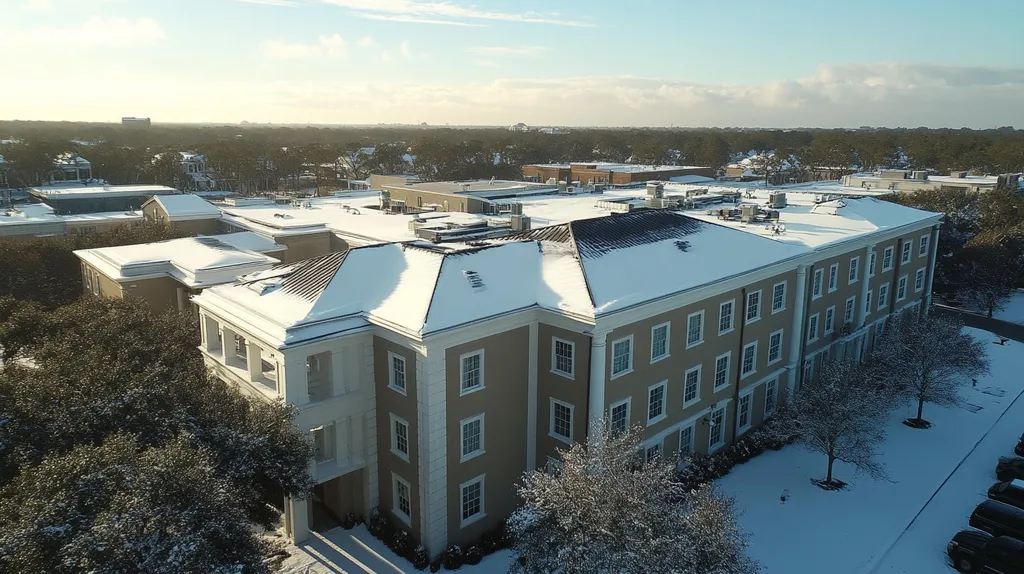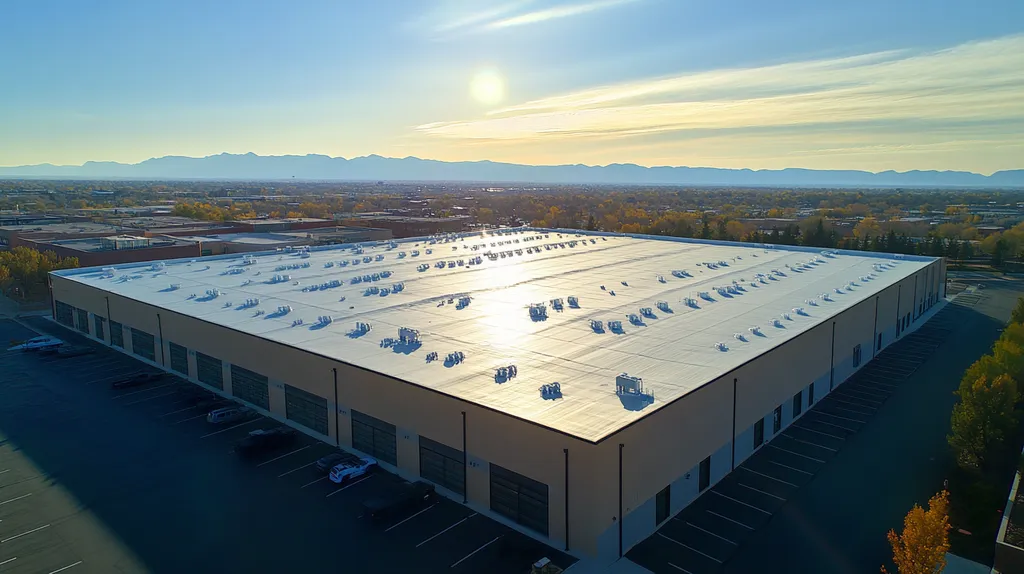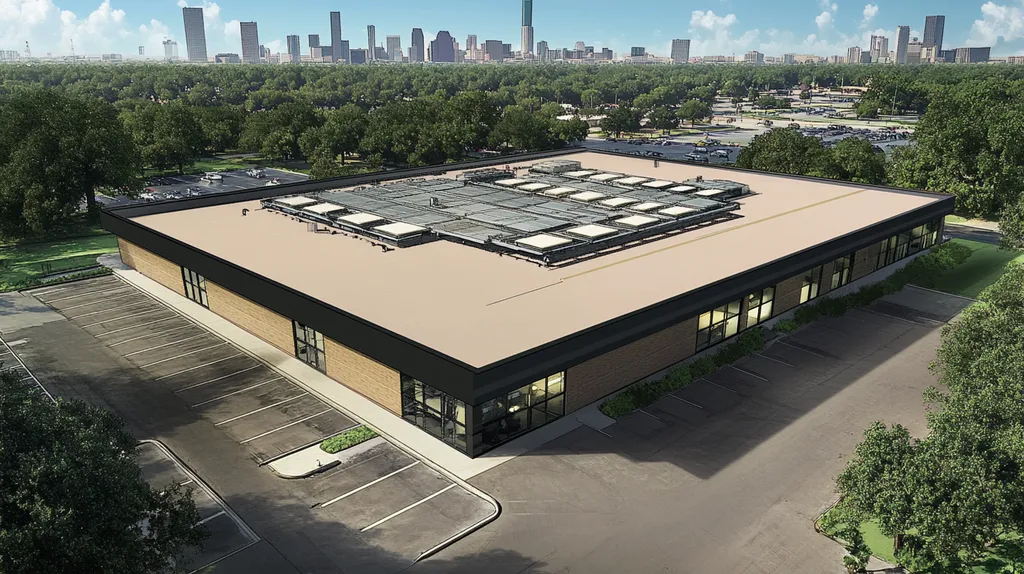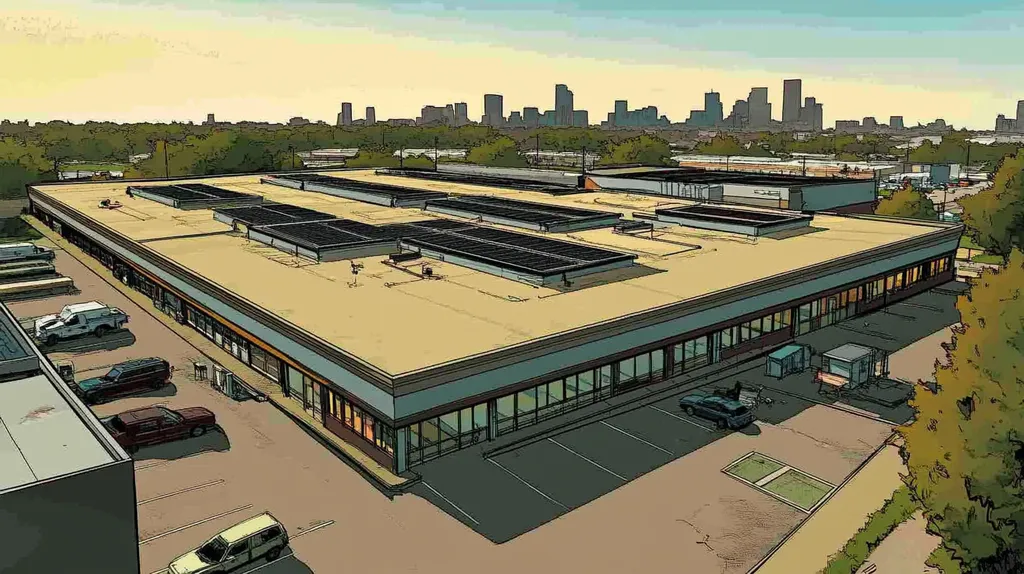Commercial property owners face a pivotal challenge: navigating increasingly complex warranty options for energy-efficient roofing systems that often exceed $1 million in installation costs. Studies show that 40% of commercial roof failures stem from misaligned warranty coverage, resulting in both voided protection and compromised energy performance.
As roofing technology advances, the intersection of warranty types, system components, and energy efficiency creates critical decision points for facility managers. Understanding these elements becomes essential for protecting substantial investments while maintaining optimal building performance.
This comprehensive guide examines six crucial aspects of commercial roof warranties, from fundamental concepts to optimization strategies, providing property owners with actionable insights for maximizing both protection and energy efficiency.
SECTION 1: FUNDAMENTAL CONCEPTS
Commercial roof warranties represent a critical intersection of risk management and asset protection for energy-efficient buildings. With replacement costs often exceeding $10 per square foot for commercial roofing systems, the financial implications of warranty decisions are substantial. Understanding warranty fundamentals becomes essential as energy-efficient roofing systems grow increasingly complex, incorporating multiple components that each require specific coverage considerations.
Types of Commercial Roof Warranties
Commercial roof warranties encompass three primary categories: material-only coverage, workmanship guarantees, and comprehensive system warranties. Material warranties focus specifically on protecting against manufacturing defects in roofing components, ensuring they perform as specified under normal conditions.
Workmanship warranties address installation quality, covering issues that arise from improper application or assembly of roofing materials. These warranties typically range from 2 to 10 years and may include specific provisions for energy-efficient components.
System warranties provide the most extensive protection by combining material and labor coverage. Leading manufacturers like GAF offer system warranties extending up to 35 years, with options for coverage of both standard and energy-efficient roofing components. (source: GAF)
Manufacturer vs. Contractor Warranties
Manufacturer warranties originate from the companies producing roofing materials and typically cover defects in the actual products. These warranties often include specific performance standards for thermal resistance, reflectivity, and other energy-efficiency metrics.
Contractor warranties focus on installation quality and workmanship. These guarantees ensure proper application of energy-efficient materials and systems, including correct installation of thermal barriers and reflective coatings.
The relationship between these warranty types becomes particularly important with energy-efficient roofing systems. A manufacturer’s warranty may cover material performance, but improper installation can compromise energy efficiency benefits even if materials meet specifications.
Warranty Duration and Coverage
Warranty durations vary significantly based on roofing system type and energy efficiency features. Standard coverage typically ranges from 10 to 30 years, with premium energy-efficient systems often qualifying for extended terms.
Coverage scope differs among providers, with some warranties including specific provisions for energy performance metrics. These may guarantee thermal resistance values, solar reflectance indices, or overall system efficiency over time.
Most warranties require regular maintenance and documentation to remain valid. This includes periodic inspections of energy-efficient components and prompt repairs to maintain system performance.
Understanding coverage limitations is crucial, as warranties may exclude damage from extreme weather events or unauthorized modifications to energy-efficient systems. Property owners should carefully review exclusions to ensure alignment with their risk management strategies.
SECTION 2: SYSTEM COMPONENTS
Understanding roofing system components and their associated warranties has become increasingly critical as energy-efficient solutions evolve. Studies show that 40% of commercial roof failures stem from mismatched components or inadequate warranty coverage for energy-efficient elements. With installation costs averaging $15-20 per square foot for high-performance systems, proper component selection and warranty alignment directly impact both initial investment and long-term energy savings.
Material Warranties and Defect Coverage
Material warranties form the foundation of roofing protection, representing a manufacturer’s commitment to product quality and performance. At its core, these warranties pledge specific performance standards for roofing materials under normal conditions.
Coverage terms typically range from 5 to 30 years, depending on material type and energy efficiency ratings. Premium energy-efficient materials often qualify for extended warranty periods, reflecting their superior durability and performance characteristics.
Warranty validation requires proper installation by authorized contractors and adherence to maintenance schedules. This requirement ensures optimal performance of energy-efficient features throughout the warranty period.
Documentation of material specifications and warranty terms becomes especially crucial for energy-efficient systems, where component performance directly impacts building efficiency goals. (source: IBS Roofing)
System Warranties and Integrated Components
System warranties provide comprehensive coverage for the entire roofing assembly, including insulation, membranes, and energy-efficient features. These warranties ensure that all components work together effectively to maintain building performance targets.
Coverage typically extends to interface points between different materials and systems. This integration becomes particularly important where energy-efficient components meet traditional roofing elements.
Warranty terms often specify performance requirements for thermal resistance and reflectivity. Regular testing and documentation of these metrics helps maintain warranty validity and ensure continued energy efficiency.
System warranties generally offer the strongest protection for energy-efficient roofing investments by addressing both individual components and their collective performance.
Labor and Material Warranty Distinctions
Labor warranties complement material coverage by protecting against installation-related issues that could compromise energy efficiency. These warranties typically range from 2 to 10 years, depending on contractor qualifications and system complexity.
Coverage scope varies significantly between contractors, with some offering enhanced protection for energy-efficient component installation. Understanding these variations helps property owners select contractors who best support their efficiency goals.
Maintenance requirements play a crucial role in maintaining both labor and material warranty coverage. Regular inspections and documented maintenance protect warranty validity while ensuring optimal system performance.
The intersection of labor and material warranties creates a comprehensive protection framework for energy-efficient roofing investments. Clear understanding of both warranty types enables informed decision-making throughout the system lifecycle.
SECTION 3: IMPLEMENTATION METHODS
Proper implementation of energy-efficient commercial roofing systems represents a critical junction where warranty protection meets real-world execution. With installation costs for advanced roofing systems often exceeding $500,000 for large commercial buildings, errors in implementation can have devastating financial consequences. Statistics show that over 30% of roof failures stem from improper installation rather than material defects, making precise implementation methods essential for protecting both the initial investment and ongoing energy savings.
Certified Contractor Requirements
The selection of certified contractors forms the foundation of successful energy-efficient roof implementation. These professionals must maintain current certifications from major manufacturers and demonstrate expertise in specific energy-efficient systems.
Certification requirements typically include completion of manufacturer-specific training programs, documented installation experience, and ongoing education in emerging energy-efficient technologies. This ensures contractors stay current with evolving industry standards.
Many manufacturers tie warranty validity directly to contractor certification status. Using non-certified installers can void warranties before installation even begins, leaving building owners exposed to significant financial risk.
Property owners should verify contractor certifications through manufacturer databases and request documentation of recent relevant installations. This verification process protects both warranty coverage and energy performance targets.
Installation Process and Inspections
Successful installation requires a structured approach with multiple inspection checkpoints. Pre-installation inspections evaluate substrate conditions, moisture levels, and structural integrity to ensure proper system compatibility.
During installation, quality control measures must verify proper material handling, application temperatures, and seam integrity. These factors directly impact both warranty coverage and long-term energy performance.
Regular inspections and routine maintenance are essential to keeping commercial roof warranties in good standing with manufacturers. Documentation of these inspections serves as crucial evidence for warranty claims and performance verification. (source: IBS Roofing)
Final inspections must confirm proper installation of all energy-efficient components, from vapor barriers to reflective coatings. This verification ensures the system meets both warranty requirements and designed efficiency targets.
Compliance with Manufacturer Specifications
Manufacturer specifications establish precise requirements for material storage, handling, and installation sequences. These guidelines ensure optimal performance of energy-efficient components and maintain warranty validity.
Temperature restrictions, cure times, and application methods must align exactly with manufacturer requirements. Deviations from these specifications can compromise system performance and void warranty protection.
Documentation of compliance becomes particularly critical for energy-efficient systems. This includes maintaining detailed records of material batch numbers, installation conditions, and quality control measures.
Regular updates to manufacturer specifications require constant attention from installation teams. Staying current with these requirements ensures continued warranty protection and optimal system performance.
SECTION 4: MAINTENANCE REQUIREMENTS
Proper maintenance of energy-efficient commercial roofs represents a critical investment protection strategy, with research showing that neglected systems lose up to 40% of their expected lifespan. For a typical 50,000-square-foot commercial roof, premature replacement can cost upwards of $500,000. Beyond financial implications, poor maintenance directly impacts energy efficiency, with degraded systems showing up to 50% reduction in thermal performance.
Annual Inspection and Repair Needs
Professional roof inspections should occur at minimum twice annually – once in spring to assess winter damage and once in fall to prepare for severe weather. These inspections must evaluate membrane integrity, flashing conditions, and drainage systems.
Energy-efficient components require specialized attention during inspections. Thermal imaging can identify insulation compromise, while reflectivity testing ensures cooling properties remain within specified ranges.
Inspection findings must trigger immediate repairs to maintain warranty validity. Even minor issues can escalate rapidly, compromising both system integrity and energy performance.
Repairs should only be performed by manufacturer-certified contractors familiar with energy-efficient systems. Using non-authorized personnel for repairs risks voiding warranty coverage and damaging specialized components.
Preventative Maintenance Strategies
Effective preventative maintenance begins with establishing a comprehensive program that addresses both standard and energy-efficient components. This program should detail inspection schedules, maintenance procedures, and response protocols for various issues.
Regular cleaning of drainage systems and removal of debris prevents water accumulation that can degrade insulation performance. Monthly visual inspections can identify potential problems before they impact energy efficiency.
Seasonal maintenance tasks must adapt to climate conditions. Winter preparations should focus on preventing ice damage, while summer maintenance emphasizes protecting reflective coatings and managing thermal stress.
Building staff should receive training in basic inspection procedures and emergency response protocols. This first-line defense helps identify issues early while maintaining proper documentation for warranty purposes.
Documentation for Warranty Validation
Warranties for energy-efficient roofing systems require meticulous documentation of all maintenance activities. GAF’s system warranties, extending up to 35 years, mandate specific maintenance records to maintain coverage validity. (source: GAF)
Documentation must include detailed inspection reports, repair records, and photographic evidence. These records should specifically note the condition of energy-efficient components and any changes in performance metrics.
Maintenance logs should track both scheduled activities and unexpected repairs. This comprehensive record helps identify patterns and predict potential issues before they compromise system performance.
Digital documentation systems streamline record-keeping and ensure accessibility. Cloud-based platforms allow multiple stakeholders to access and update maintenance records while maintaining a clear audit trail for warranty purposes.
SECTION 5: PERFORMANCE METRICS
Performance metrics for energy-efficient commercial roofing warranties directly impact both immediate costs and long-term value. With replacement expenses often exceeding $500,000 for large facilities, understanding these metrics becomes crucial for strategic planning. Industry data reveals that properties with well-matched warranty coverage and performance tracking see up to 40% longer roof lifespans and 25% lower energy costs. Proper evaluation of warranty effectiveness, cost-benefit ratios, and efficiency impacts helps stakeholders optimize their roofing investments.
Measuring Warranty Effectiveness
Warranty effectiveness measurement begins with clear performance benchmarks for both protection and energy efficiency. Key indicators include coverage retention rates, response times for claims, and documented energy savings over time.
Successful warranty programs demonstrate measurable impacts through reduced maintenance costs and improved energy performance. Properties with comprehensive warranty coverage typically see 15-20% lower annual operating costs compared to those with basic protection.
Regular performance audits help identify potential gaps in warranty coverage before they impact building operations. These assessments should track thermal performance, moisture protection, and overall system integrity.
Digital monitoring systems now enable real-time tracking of roofing performance against warranty specifications. This technology allows facility managers to document compliance and identify potential issues before they escalate to warranty claims.
Cost-Benefit Analysis of Warranty Options
Metal roofing systems demonstrate superior long-term value through extended lifespans of 40-50 years and reduced maintenance requirements. Their recyclable composition and energy-efficient properties provide additional cost benefits while supporting sustainability goals. (source: AEC Daily)
Initial warranty investments must be weighed against projected energy savings and maintenance reduction. Premium coverage options often deliver positive returns through decreased operational costs and extended system longevity.
Warranty cost analysis should include potential energy rebates and tax incentives available for high-performance roofing systems. These financial benefits can significantly offset initial premium costs for comprehensive coverage.
Life-cycle cost comparisons reveal that warranties emphasizing energy efficiency often provide better long-term value. Properties with performance-based warranty coverage typically achieve 20-30% better return on investment over the system’s lifespan.
Impact on Roof Longevity and Efficiency
Comprehensive warranties that include regular inspections and maintenance requirements directly contribute to extended roof life. Systems under performance-based warranty protection consistently achieve their full expected lifespan.
Energy efficiency metrics within warranty terms help maintain optimal system performance. Regular evaluation of thermal resistance and reflectivity ensures continued energy savings throughout the warranty period.
Modern warranty programs increasingly incorporate sustainability metrics alongside traditional performance measures. This approach helps properties maintain both protection levels and environmental benefits over time.
Performance-based warranties drive continuous improvement in roofing system efficiency. Properties utilizing these warranties report average energy savings of 15-25% compared to traditional coverage options.
SECTION 6: OPTIMIZATION STRATEGIES
Strategic warranty optimization for energy-efficient commercial roofs can mean the difference between protected assets and devastating losses. With replacement costs routinely exceeding $750,000 for large commercial facilities, choosing and managing warranties demands careful attention. Research shows that properties with optimized warranty strategies achieve 30% longer roof lifespans and maintain peak energy efficiency up to 40% longer than those with basic coverage.
Selecting the Right Warranty for Your Roof
Warranty selection must align with both immediate protection needs and long-term performance goals. Premium coverage options often deliver superior value through decreased operational costs and extended system longevity.
GAF’s System Pledge™ and Diamond Pledge™ NDL warranties provide comprehensive protection covering both material defects and workmanship for up to 35 years. These transferable guarantees include replacement materials and labor costs, with options for extended coverage through the WellRoof® Guarantee Extension. (source: GAF)
Energy performance requirements should factor heavily into warranty decisions. Coverage terms must specifically address thermal resistance, reflectivity, and other efficiency metrics critical to system performance.
Regional climate considerations play a crucial role in warranty optimization. Properties in severe weather zones require enhanced coverage for weather-related impacts that could compromise energy efficiency.
Maximizing Warranty Benefits and Coverage
Effective warranty utilization requires proactive management through every phase of the roof lifecycle. Regular performance monitoring helps identify potential issues before they escalate into warranty claims.
Digital tracking systems enable real-time monitoring of warranty compliance metrics. These platforms streamline documentation while providing early warning of developing problems.
Strategic partnerships with certified contractors strengthen warranty protection. Using authorized installers for all maintenance and repairs ensures work meets manufacturer specifications while preserving coverage validity.
Regular staff training on warranty requirements and response protocols creates a first line of defense. This knowledge base helps maintain compliance while maximizing protection value.
Integrating Warranties into Roofing Budgets
Comprehensive budget planning must account for both initial warranty costs and ongoing compliance expenses. Premium coverage options often deliver positive returns through reduced maintenance needs and extended system life.
Warranty-related budget allocations should include provisions for required inspections, documentation systems, and preventative maintenance. These investments protect coverage validity while optimizing system performance.
Energy efficiency incentives and tax benefits can offset premium warranty costs. Many jurisdictions offer financial advantages for maintaining high-performance roofing systems under comprehensive warranty protection.
Life-cycle cost analysis reveals that performance-based warranties typically deliver 25-35% better return on investment compared to basic coverage options. This improved value stems from both enhanced protection and sustained energy efficiency.
Looking Ahead
With commercial roofing costs exceeding $1 million for large facilities and energy costs rising 12% annually, selecting the right warranty coverage has never been more critical for property owners.
Research shows that optimized warranty strategies can extend roof lifespans by 30% while maintaining peak energy efficiency up to 40% longer than basic coverage options.
Success requires understanding the interplay between material warranties, labor guarantees, and system coverage while maintaining strict compliance with maintenance requirements.
As energy-efficient roofing technology continues to evolve, property owners who align their warranty selection with performance goals, maintenance capabilities, and budget constraints will maximize both protection and return on investment.
The future of commercial roofing depends on this strategic integration of warranty protection and energy performance.
FREQUENTLY ASKED QUESTIONS
Q. What are the main types of commercial roof warranties?
A. There are three primary types of warranties: material-only coverage, workmanship guarantees, and comprehensive system warranties. Material warranties cover defects in roofing materials, while workmanship guarantees focus on installation quality. Comprehensive system warranties offer the most extensive protection by combining both material and labor coverage.
Q. How do I ensure comprehensive coverage for my industrial roof?
A. To ensure comprehensive coverage, select a warranty that includes both material and labor coverage. Additionally, verify that all system components are compatible and warrantied, and ensure that certified contractors perform the installation to maintain coverage validity.
Q. What role does contractor certification play in warranties?
A. Contractor certification is crucial as it ensures the contractor is trained in proper installation practices and understands warranty requirements. Many manufacturers tie warranty validity to the certification status of installers, so using certified contractors protects your investment in the roofing system.
Q. How can property owners maintain warranty validity?
A. Property owners can maintain warranty validity by conducting regular inspections, performing necessary maintenance, and using authorized contractors for repairs. Keeping detailed documentation of all activities related to the roofing system is essential for validating the warranty and ensuring it remains in effect.
Q. What are the benefits of performance-based warranties?
A. Performance-based warranties offer benefits such as extended roof lifespan and improved energy efficiency. They typically require regular evaluations, ensuring the roofing system maintains optimal performance and meets specified energy metrics, translating to lower operational costs over time.
Q. How do I choose the best warranty for my commercial roof?
A. Choosing the best warranty requires assessing your specific needs, such as coverage duration, risk factors, and energy performance metrics. Consider warranties that align with your facility’s climate, and review manufacturers’ options that provide comprehensive coverage with a proven track record of reliability and performance.
Q. What common mistakes should I avoid with commercial roof warranties?
A. Avoid common mistakes like neglecting to read the fine print, failing to document maintenance, and choosing non-certified contractors for installations. Not keeping up with regular inspections and repairs can lead to warranty voids, ultimately turning your investment into a liability rather than an asset.











